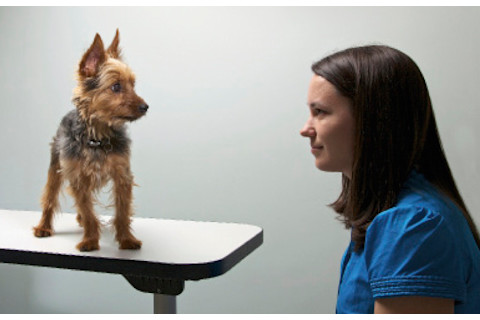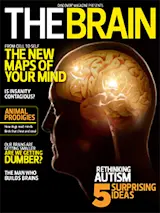
Graduate student Kara Schroepfer with Napoleon, a Yorkshire terrier, at the Canine Cognition Center. | Vincent J. Musi
Tail chasers. Ball fetchers. Security guards. We tend to value dogs for their loyalty and charm, not for their brains. Now new research from evolutionary anthropologist Brian Hare of Duke University shows that dogs may be smarter than we give them credit for; in some cases, they may even outsmart our primate relatives. Hare, who directs Duke’s Hominoid Psychology Research Group and the Duke Canine Cognition Center, studies the relationship between social behavior and cognition in animals. He finds that chimpanzees and bonobos (their close cousins, and ours) are not the only animals whose brains offer clues to human evolution. The success of man’s best friend may shed light on the success of man, Hare believes: Well before we domesticated dogs, we became domesticated ourselves.
Dogs are so familiar to us, yet you say that we underestimate their intelligence. How so?
H: Our most famous discovery is that dogs are actually quite good at understanding communicative gestures. I think scientists were more surprised by this than dog owners. Relative to great apes, dogs’ abilities to understand human communication are quite flexible. They may be more similar to us in that regard than our genetically more closely related relatives.
How did you discover dogs’ hidden skill?
H: We designed a test in which food is concealed beneath one of two cups, and a helpful human attempts to tell the dog where the food is hidden. The human can point to the food, look at it, and so on. It ends up dogs are really good at interpreting these cues, and they find the food at rates significantly above chance. But we’re not interested in something like a stupid pet trick that might show up on Letterman, since you can train an animal to do anything. We’re interested in spontaneity and flexibility. Specifically, we wanted to know whether the dogs could solve a completely new problem. For example, I put a visual barrier in front of the cups. After I show the dog a block, I place it on the cup with the food, and then I remove the barrier. The dog will go to the correct cup, because he’s seen a human holding the block. Dogs use the block as a marker to find the food under the cup. We did control sessions before and after the test where I would put the block on the cup while the dogs were in another room. When the dogs don’t see me touch the block, they don’t use it to identify the right cup. So it really is a communicative thing.
Where do you think this kind of skill comes from?
H: We have entertained three hypotheses. The most obvious is that it’s the result of learning, because dogs live with humans and interact with us for thousands of hours. But at just six to nine weeks their eyes are barely open and they can perform this communication task, which is crazy. It doesn’t correlate with age, and it doesn’t correlate with experience.
The next hypothesis is maybe dogs are doing this just because somehow canids are really good at using social cues in general. They’re predators. If you’re a predator, picking up the social cues of another species would be important. Say you’re chasing down a deer and it looks to the left; well, you might want to be able to predict where the deer is going next. But we found no evidence that wolves were particularly good at using human social cues in the flexible manner that dogs can.
So then we started thinking about the evolution of domestication. But how do you test that? We can’t time travel and see what people actually selected for. Except! In Siberia, researchers experimentally domesticated foxes for 50 years. Their protocol was simple: If a fox approached them, they bred it for the next generation. If the fox ran away, they didn’t. So we went over there and looked at how the foxes use human gestures. Basically, we found that because they are domesticated, they are better at interpreting human gestures.
How does simply being domesticated lead to an ability to understand our gestures?
H: Well, why aren’t chimps good at it? Normally, in their social interactions, they’re not communicating with each other in a cooperative manner, especially when it comes to finding food. It’s not like chimps run around saying, “Hey look, there’s a grape over there, do you want it?” No way—they eat it! For them, trying to be helpful is the curveball.
What I think happens when you domesticate a fox (or a dog) is that the fox stops thinking of you as someone who’s going to eat him and starts seeing you as a friend. They start using the social skills that they use with other foxes. What we showed was surprising. We’d assumed you must select for a smarter animal to have a species become smarter, but our work shows this is not the only way. You can select for a nicer animal, and it becomes smarter—able to solve problems it could not solve before.
Are you studying animal cognition for its own sake, or is your research also telling you something about the nature of human smarts?
H: Both. Some dogs help people with disabilities, some help people find bombs. We’re hoping our research is going to help those people help the dogs do a better job by understanding how to train them and also what they can’t be trained to do. Just to give you a quick example, there are different navigational strategies that animals use. If you’re a blind person with a service dog, you might want to know which one your dog is using.
Are the brains of dogs dramatically different from those of wolves?
H: The prediction would be that any regions of the brain having to do with emotional reactivity, like the amygdala and hypothalamus, or with controlling aggressive responses, such as the prefrontal cortex, should be really different. The genomes of bonobos and chimps are almost identical, and wolves and dogs are close to being identical, but that doesn’t mean the genes in the actual tissues are being expressed in any remotely similar way. What we really need are more gene expression studies, and the field is not there right now.
You also study bonobos. How do those studies relate to your ideas about our own social cognition?
H: Bonobos are far more prosocial than chimpanzees. Female bonobos simply don’t tolerate male aggression. When bonobos have intergroup interactions, instead of trying to kill each other they have sex, like crazy orgies. What we’re doing right now is trying to understand the genetics that relate to the behavioral differences between bonobos and chimps, and look for that same genetic signature in humans. Are we like bonobos, and is that the reason we can somehow live in dense populations and not scratch each other’s eyeballs out? Bonobos are the dog of the ape world. The question is, are we also?
You argue that dogs began to evolve away from wolves when friendlier canids began approaching humans for food scraps. How did that unfold?
H: What happened 15,000 years ago changed humans in a very important way, which is—drumroll—the beginning of agriculture. What happens when you have agriculture? You’re not going to be moving around as much, and you start producing a lot of garbage. Well, you know, delicious—for a protodog. You’ve just created a new ecological niche.
And for dogs, what a great payoff, because they’re socially interacting with the most powerful tool on the planet. I don’t need to be smart because I have this thing that does everything! It’s like having an iPad.
So humans are to dogs as iPads are to humans. Is that the bottom line?
Exactly.














